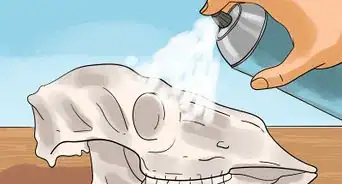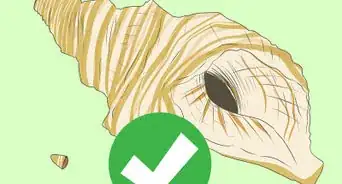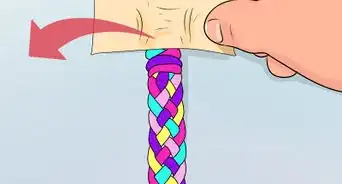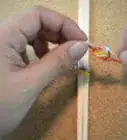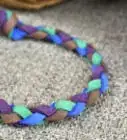This article was co-authored by wikiHow Staff. Our trained team of editors and researchers validate articles for accuracy and comprehensiveness. wikiHow's Content Management Team carefully monitors the work from our editorial staff to ensure that each article is backed by trusted research and meets our high quality standards.
The wikiHow Video Team also followed the article's instructions and verified that they work.
This article has been viewed 268,525 times.
Learn more...
A round braid is a type of braid used for making jewelry, slings, straps, etc. out of string, yarn, twine, cord, leather, and more. This braid requires an even number of strands, but four or eight are most common. Choose the number of strands and the colors you want to use, then get started on your own 4- or 8-strand round braid.
Steps
Starting a Round Braid
-
1Choose the colors for your braid. Decide on the colors that will appear in your round braid. Select just one or two, or up to as many as four or eight different colors, depending on which type of braid you do.
- For a 4-strand round braid, one or two colors are typically used in different configurations, but you can use up to four different colors for each strand if you wish.
- For an 8-strand braid, typically one or two colors are used to create patterns, but you can use as many as eight different colors for each strand.
-
2Tie strands together at the end. Tie the pieces of material you will use for your braid together at one end. Use a simple overhand knot (tying all four pieces around themselves) to secure them together.
- You can fold over one longer piece of your material to create two strands, in which case you will tie together the loop ends of the folded pieces. Remember that this will create two strands of the same color when you plan out what colors you will use.
- Don’t worry about how neat or perfect this knot is, as you will likely redo it or use a fastening instead to complete your final braided item.
Advertisement -
3Secure the end of your material to something. Fasten the knotted end of your strands to an object that will keep them firmly in place while you are pulling and tightening the strands to create the braid. Tape the end to a work surface, loop it over a hook, pin it to your pant leg, or whatever method works for you.[1]
- If you prefer to work on a flat surface to help keep your strands in order, opt for taping the end down to a table or other horizontal surface that your material can lay flat on.
- If you prefer to keep tension on the strands and hold onto and manipulate them with your fingers the whole time, opt for suspending the end from a hook or an angled surface that you can pull the strands out from.
-
4Arrange your colors for a 4-strand braid pattern. Decide on how you’d like your colors to appear once they are braided, and arrange the strands accordingly. Two colors on a 4-strand round braid can create a spiral or diamond shapes, depending on what order the colored strands are in when you begin.
- Begin with two strands of the same color in the middle, and the outside two strands in a different color, for a pattern that will look like a spiral. In other words, you can hold one strand of each color in each hand if you are holding onto the strands to braid.
- Begin with two strands of one color on the left and two strands of another color on the right for a pattern that will look like diamond shapes or a square with four colored sides. In other words, hold one color in one hand and one color in the other if you’re holding onto the strands the whole time to braid.
-
5Arrange your colors for an 8-strand braid pattern. Decide on how you want your colors to look once included in an 8-strand braid. Arrange the strands according to whether you’d like a large chevron, small chevron, or stripe pattern for your completed braid.
- For a two-color wide chevron pattern that appears on two sides of the braid, place two strands of each color on the left (or in your left hand) and two strands of each color on the right (or in your right hand). Four strands of the same color should all be next to each other in the middle.
- For a two-color narrow chevron pattern that appears on all four sides of the braid, arrange the strands alternately with a strand of the first color, then a strand of the second color, then a strand of the first color, and so on.
- For two-colored stripes down the braid, place all four strands of one color on the left (or in your left hand) and all four strands of the other color on the right (or in your right hand).
Making a Round Braid with 4 Strands
-
1Move the rightmost strand underneath the two middle strands. Lay out your strands or hold them in your hands so they are separate from each other. Use the strand on the far right and pass it under the two strands in the middle.
- If it helps you, you can think about labelling the strands from left to right as A, B, C, and D when you begin. Bring the D strand underneath C and B so that the order is now A, D, B, C.[2]
- Either place your strands carefully on a flat surface or hold them tightly in your hand, as they must remain in order throughout the braiding.
-
2Wrap that strand over and between the two middle strands. Take the rightmost strand that you just moved under the two middle strands. Wrap it over one of those middle strands so that it falls in between the two of them.
- If you’re using letters to label your strands, you would be taking the D strand and placing it over B so that it is in between B and C. The order from left to right would then be A, B, D, C.
- Tighten the strands up toward your end knot so that the braid stays even. Make sure the strands stay spread out in the same way as when you began, even though some will have changed positions.
-
3Bring the leftmost strand under the two middle strands. Take the strand that’s on the far left and bring it underneath your current two middle strands. This mirrors the same first step you took with the strand on the right.
- Your lettered strands were A, B, D, C from left to right after tightening the first side. You will now take the A strand and bring it underneath B and D. Thus the new order will be B, D, A, C.
- Remember to keep all strands carefully in place while you braid, whether laying them out neatly on a table or holding them firmly in your hands.
-
4Bring that strand over and between the two middle strands. Hold the far left strand that you just brought under the two middle strands. Wrap it back over so it falls in the between those two strands.
- If following letters from the previous step that ended in the order B, D, A, C: Bring A over D so that it rests in between B and D. The new order from left to right will then be B, A, D, C.
- Tighten the strands up toward your end knot to keep the braid looking even. Now you have completed this sequence on both the right and left side. Keep the strands separated in the same way as you begun, even though they are now in a different order.
-
5Repeat these steps down the length of your material. Continue moving the rightmost strand under the middle two strands and over to rest in between them, then do the same to the leftmost strand. Repeat these motions over and over until you reach your desired length or the end of your material.
- If you forget what side you left off on at any point, you can tell which strand to start with because either the rightmost or leftmost strand will appear slightly higher up where it comes out of your braid. This is the strand to move next.[3]
- Pause occasionally if you are using very long pieces of material for your braid to untangle them at the ends. Ensure that you don’t lose the order of your strands by holding them down with your hand or another heavy flat object while you gently untangle the ends.
Making a Round Braid with 8 Strands
-
1Separate half the strands to the right and half to the left. Lay out and separate each of your strands flat on the table, with four of them to the right, four to the left, and a space in between them in the middle. You can also hold four strands in each hand if you choose to use that method for braiding.
- Make sure you pay attention to where colors are placed if you’re going for a certain pattern.
- As you start making your braid, you should return to this placement of four strands to the left and four to the right to ensure that the strands stay neat and in order.
-
2Take the rightmost strand and bring it under five other strands. Take the strand that’s on the far right of all eight of your strands. Bring it under the three other strands that you have extending to the right, as well as under two of the strands extending to the left.
- If you’d like to use letters to help keep track of the strands, you can label them A, B, C, D . E, F, G, H, with the "." indicating the space you should leave between the two groups of strands. Take the H strand and bring it underneath G, F, E, D, and C so that it rests in between B and C. The new order would be A, B, H, C . D, E, F, G.
- Keep the strands arranged so that some extend out to the right and some extend out to the left. Once you move the rightmost strand in this step, there will temporarily be five strands on the left and only three on the right.
-
3Bring that strand back over the last two strands. Take the strand you just moved underneath five other strands and bring it back over the last two. This will place the strand back over with the group of strands on the right, but in a new position toward the middle.
- With lettering, take the H strand from its position between B and C at the end of the previous step. Wrap it over C and D to rest next to E on the right side. The new configuration would be: A, B, C, D . H, E, F, G.
- Tighten the strands by pulling up toward the end knot. It’s essential that you keep four strands on the right and four on the left, even though you’ve changed the positions of the strands slightly.
-
4Take the leftmost strand and bring it under five other strands. Pick up the strand on the far left of all your strands and bring it under the three others on the left, as well as two of the strands on the right. This repeats the same thing you did with the rightmost strand, this time on the left side.
- With lettered strands after the previous steps, the order was A, B, C, D . H, E, F, G. Now, take the A strand and bring it under B, C, D, H, and E so that it rests between E and F.
- Just like on the first side, this will temporarily make it so that there are now five strands on one side (the right this time) and only three strands on the other (the left this time).
-
5Bring that strand back over the last two strands. Take the strand you just moved from the left and under five other strands. Wrap it back over the last two strands so that it resumes its place with the other three strands on the left, but now in a new position toward the middle.
- With lettering, you’ll move the A strand that you placed between E and F previously. Take it over E and H so that it rests on the other side next to D. The order then becomes B, C, D, A . H, E, F, G.
- Tighten the strands up toward the end knot and you have now completed the same thing on both sides. Keep four strands on the right and left like you do to begin, even though they are now in a different order.
-
6Repeat these steps for the rest of your material. Continue moving the rightmost strand under the next five strands and back over the last two, then do the same to the leftmost strand. Repeat these motions over and over until you reach your desired length or the end of your material.
- If at any point you forget what side you left off on, the strand to start with is the rightmost or leftmost strand that appears slightly higher up where it comes out of your braid.[4]
- Pause to untangle your strands if you are using long pieces of material. Keep the order of your strands by holding them down with your hand or another heavy flat object while you gently untangle the ends.
Community Q&A
-
QuestionWhy don't the text instructions match the videos?The instructions are somewhat complex and the video does not demonstrate it with 4 different colored cords. Use some different colored yarn/cord to get a feel for this particular method. Go to a manufacturer's website to find free instructions on how to use the product.
-
QuestionWhat if I am making a whip and the braid needs to go around the core of the whip?
 Community AnswerDecide on the number of stands you want to use to wrap your core. To form a basic braid around the core: Start with an even number of cords and secure them around your core base. Place a marker on alternate cords. Place plain cord over marked cord and repeat around the core, snug up to the base. For the next round, put plain cord under marked cord, again, snug up to the base. Repeat until it's your desired length. Secure the end. This is a simplified version, there are plenty of tutorials about how to make a whip on the web.
Community AnswerDecide on the number of stands you want to use to wrap your core. To form a basic braid around the core: Start with an even number of cords and secure them around your core base. Place a marker on alternate cords. Place plain cord over marked cord and repeat around the core, snug up to the base. For the next round, put plain cord under marked cord, again, snug up to the base. Repeat until it's your desired length. Secure the end. This is a simplified version, there are plenty of tutorials about how to make a whip on the web. -
QuestionHow to tie off and attach a clasp?End caps can be used to finish off the cord. Depending on the desired effect, the secured end (wrap with finer cord) with added glue is inserted into the end cap or a coiled wire crimp. The clasp can then be added. This can add extra length, so be aware of this when choosing your finding. Super glue can also be used to secure the cord ends. Apply the glue on uncut cord first and allow to dry before cutting. This will give a clean and neat end for an end cap finding. Review online videos on the topic for details.
References
About This Article
A round braid can be used to make jewelry, slings, straps, and more. The most common round braids use 4 or 8 strands. To start your braid, pick your colors and tie your strands together at the end in a simple overhand knot. Secure the end of your material to a flat work surface with a piece of tape. For a 4-strand round braid, move the rightmost strand under the 2 middle strands. Then, take the strand you just moved and feed it under the 2 middle strands. Take the strand on the far left and bring it under your current 2 middle strands. Now take this same strands and wrap it back over so it falls between the 2 middle strands. Repeat these steps down the length of your material. To learn how to make a round braid with 8 strands, keep reading!

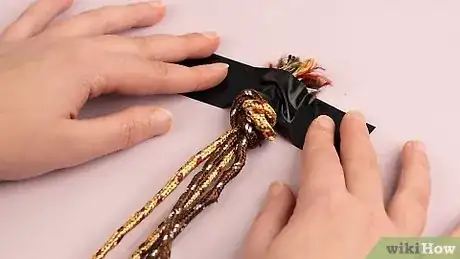
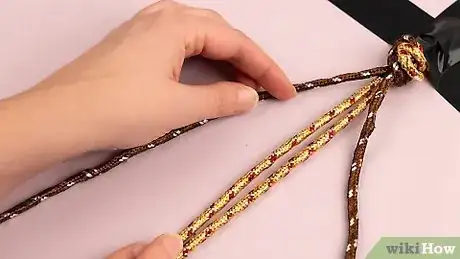




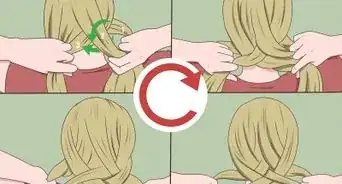

-Step-11.webp)
